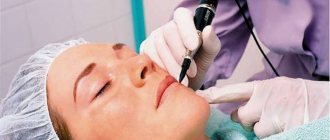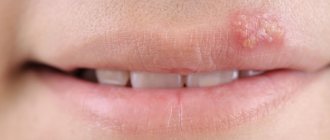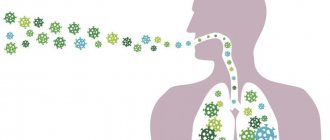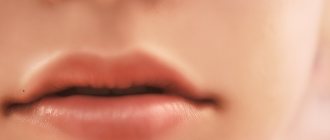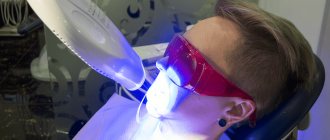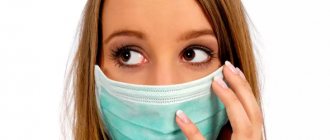How do they look
Fordyce spots visually look like yellowish granules or swellings that are clearly visible on the lips.
The main area of their concentration is the area near the sebaceous ducts. They are located not on the surface, but under the skin. At their core, they are sebaceous formations that gradually accumulate and form something like a bubble or granule. They were first discovered and studied by dermatologist John Addison Fordis (a specialist from the USA). He was the first to give a detailed description of formations in medical literature.
The granules are similar in size to grains of rice. Most often, neoplasms appear in size about 1-3 mm. 1-2 pieces are formed or combined into a group of 20-30 papules. Clearly noticeable when smiling (stretching lips). They do not contain or spread bacteria or viruses. In medicine, the phenomenon is classified as a skin condition, but not a disease.
The main harm to a person is psychological discomfort . Research statistics show that the problem is present in 36% of women and 60% of men. The age when granules may first appear is 13-16 years. Age corresponds to a period when the body undergoes rapid changes in hormones.
Kinds
Fordyce granules on the lips do not require strong exposure to antibiotics or special treatment with hospitalization. They should be removed if there are too many formations.
Doctors distinguish the following types of vesicles :
| Possible sizes |
|
| Colors |
|
| Peculiarities |
|
| Location |
|
By location
Location on the inside of the lips
According to this feature, granules can be located:
- on the outside of one lip;
- on the outer side of the two lips;
- on the inside;
- from each side;
- in the center;
- On the sides;
- closer to the cheeks (from the outer and inner sides).
They can feel either smooth or rough to the touch. By size - small or large.
By shape
One of the forms of formations
There are several different forms of formations:
- cysts;
- cones;
- granules;
- spots;
- granules;
- bloating.
Sometimes they are shaped like small, light-colored pimples (they have no volume).
By stage
Granules are divided into stages of development (appearance):
- present from birth (visually invisible);
- appear on the skin at the time of puberty (on average 13-16 years);
- during the period of growing up, at an older age they become clearly visible upon visual inspection.
The impetus for development or increase in quantity is given by hormonal changes in the body. Doctors believe that closely located sebaceous glands or their incorrect location - at the very edge of the lips or mucous membrane - contribute to the formation of nodules. At older ages (after 45 years), the number of sebaceous glands increases. At this stage, the granules become visually similar to white cones.
Important! In some cases, granules are confused with protruding herpes. The main difference between these formations is that herpetic manifestations look like a cluster of blisters. Inside contains a clear or light yellow liquid. Over time, they burst and become crusty.
One of the rare skin diseases of interest to dermatologists is Fordyce angiokeratomas (Fordyce angiokeratomas of the scrotum/vulva).
Angiokeratomas are vascular tumors formed by persistent subepidermal capillary dilations and changes in the epidermis with symptoms of hyperkeratosis, papillomatosis and acanthosis.
There are several clinical forms of angiokeratoma: limited angiokeratoma, nevoid angiokeratoma of the Mibelli fingers, solitary papulous angiokeratoma of the scrotum/vulva of Fordyce, diffuse angiokeratoma of the Fabry trunk.
Fordyce's angiokeratomas (Fordyce's angiokeratomas of the scrotum/vulva) were described in detail in 1895 by researcher Fordyce. This type of angiokeratoma is a developmental defect. The disease is benign. To date, it has not been possible to identify the genetic cause of Fordyce disease [1, 2].
Clinical picture.
This type of disease is manifested by the formation of multiple brown-red nodules located on the skin of the scrotum, less often on the penis and inner thighs. In women, rashes appear on the thighs and labia. Vascular nodules are bright red in color, gradually increase in size, and their color becomes darker.
Nodules with Fordyce angiokeratoma are small - 1-5 mm in diameter, the surface of the skin over them is smooth, less often - hyperkeratotic. Sometimes patients complain of itching; most patients have no subjective sensations [1, 2].
When scratched, pressed, or rubbed with linen, angiokeratomas begin to bleed. If bleeding occurs frequently, then Fordyce's disease can cause the development of mild iron deficiency anemia.
Scrotal angiokeratomas may be associated with varicocele, inguinal hernia, or thrombophlebitis. Angiokeratomas of the vulva are much less common than angiokeratomas of the scrotum, mainly in older women. In young patients, vulvar angiokeratomas may develop due to increased venous pressure during pregnancy or the use of oral contraceptives.
Diagnostic methods.
The diagnosis is relatively simple and is based on characteristic clinical data. In some doubtful cases (severe hyperkeratosis) is confirmed by the results of histological examination.
Histological picture
. The phenomena of hyperkeratosis, acanthosis, and papillomatosis are observed. The capillaries are sharply expanded and located close to the upper layer of the epidermis or in its outgrowths. Some capillaries contain lymph [3].
The prognosis is favorable
. Complications are rare and uncharacteristic. Only in rare cases (when scratched or injured by clothing) angiokeratomas of the scrotum and vulva can cause minor bleeding [4, 5].
Differential diagnosis
carried out with melanoma, lymphangioma, hemangiomas, Kaposi's sarcoma.
Considering that the localization of Fordyce angiokeratomas in the area of the glans penis is extremely rare, we present the results of our clinical observation.
Patient X
., 21 years old, applied to the center for viral pathology of the skin on January 26, 2015 with complaints of a rash in the area of the glans penis, the inner layer of the foreskin (see picture).
Clinical manifestations of Fordyce angiokeratoma in patient X.
History of the disease.
He considers himself sick for about 3 months, when he first noticed the appearance of rashes in the area of the glans penis, which gradually increased in size, spread to the inner layer of the foreskin and did not cause subjective sensations. When contacting a commercial medical center, the patient was diagnosed with “Anogenital warts.” To clarify the diagnosis, the patient was sent to the center for viral pathology of the skin of the Babushkinsky branch of the Moscow Scientific and Practical Center of Culture and Culture of the Department of Health.
Local status
: the process is widespread, asymmetrical, sub-inflammatory in nature, localized on the skin in the area of the glans penis and the inner layer of the foreskin, represented by multiple papules of a bluish-burgundy color, tending to group, round in shape, with clear boundaries, with a diameter of 0.3-0 .8 cm.
Microflora smear
from 09/16/14 - norm;
blood for HIV, syphilis, hepatitis B and C
dated 09.18.14 - negative.
The patient was sent for a diagnostic biopsy on January 26, 2015, where several lesions were collected for pathomorphological examination with a preliminary diagnosis of Fordyce hemangiomas (?). Kaposi's sarcoma (?)".
Results of histological examination:
in the preparations there are fragments of skin formations with dilated blood vessels with flattened endothelium and the presence of blood clots in their lumens. The epidermis is flattened in places, with shallow acanthosis and focal hyperkeratosis.
Histological diagnosis
from 01/30/15: Fordyce angiokeratomas.
Thus, according to the above clinical observation, Fordyce angiokeratomas can be localized in places atypical for a given nosology, which can lead to diagnostic errors and require a histological examination to clarify the clinical diagnosis.
No conflict of interest
.
Causes of appearance, who is at risk
Experts believe that the main reason for the appearance of formations on the lips is the incorrect (abnormal) location of the sebaceous glands.
There is no exact information about the mechanics of their appearance, but doctors identify additional reasons and factors that may affect the development of the negative process:
- certain types of hormonal disorders - from temporary imbalances (due to medication) to serious diseases or complications;
- metabolic changes in the system or in the body as an integral structure;
- adolescence (puberty, the beginning of menstruation in girls);
- hyperlipidemia - the problem is a lipid disorder that is directly related to increased body fat;
- disruptions in the blood circulation process occur - as a result, the accumulation and expansion of the sebaceous glands on the surface of the skin occurs;
- genetic predisposition - the problem passes from parents to child in 90% of cases;
- skin pores are too large and clogged . Oil from the sebaceous glands can form plugs and blockages. Such conditions are ideal for the formation of Fordyce granules;
- the natural process of aging of the body - after 45-50 years, a gradual decline in metabolic processes begins, even without disturbances on the part of the body. Under these conditions, subcutaneous fat can accumulate and be deposited 2-3 times faster;
- the process of infection of the sebaceous glands - if a bacterial or fungal infection has penetrated them, then the appearance of white or yellow spots can be traced in 90% of cases. This is due to the reaction of the glands to pathogenic conditions and microorganisms;
- hormonal imbalance , a disorder due to an existing disease. In 90% of cases, the problem is a symptom of a problem such as a dysfunction or disease directly related to the functioning of the thyroid gland;
- menopause (the likelihood of rashes increases in women after 55 years);
- dysfunction of the glands;
- injury to the lip area;
- consequences (complications) of the enlargement process using hyaluron ;
- pregnancy - manifestations can occur at any week, since each woman’s body works individually;
- disruption of the adrenal cortex;
- ovarian diseases (pathological nature or consequences of age-related changes);
- disorders of the hypothalamic-pituitary system;
- the presence of habits that in 90% of cases cause harm to the body (smoking in 90% of cases);
- consequences of surgery on the endocrine glands;
- stenosis of the sebaceous gland ducts.
Problems such as being overweight or poor personal hygiene do not lead to the formation of granules on the lips. It has been noted in studies that reducing body volume (weight loss) leads to the disappearance of tumors or makes them less noticeable on the skin.
Reference! Granules in any form and quantity are not a consequence of past or existing sexually transmitted diseases and are not sexually transmitted.
Why do Fordyce granules appear, where can they be and how to get rid of them:
Fordyce granules
Fordyce granules: why they occur and how to get rid of them
For some this is an almost unnoticeable trifle, but for others it is a serious cosmetic defect. What are Fordyce granules and can they be treated? What do cosmetologists and dermatologists offer to patients who come to them with such a problem?
WHAT ARE FORDYCE GRANULES
Fordyce granules (or Fordyce disease) are light-colored pimples (sebaceous glands) that can form on the oral mucosa, cheeks, lips, female labia, surface of the male penis, breast nipples, groin area and other places on the body Currently, Fordyce granules are considered normal, but in some cases they can cause severe discomfort. Fordyce granules are also called seborrheic cysts.
According to medical statistics, Fordyce disease affects 35% of women and 60% of men. The granules do not lead to the development of complications, do not cause harm to health, and are not transmitted to a partner during sexual intercourse. Most often, patients with seborrheic cysts seek medical help because of a cosmetic defect, since these neoplasms do not cause any other complications.
FORDYCE GRANULES: REASONS
The reasons for the appearance of Fordyce granules are still unclear. Despite the name "seborrheic cysts", no connection with seborrhea has been found in Fordyce granules. Most often, these neoplasms occur during puberty, when hormonal changes in the body give rise to the appearance of sebaceous gland cysts.
The current prevailing view is that the main cause of Fordyce granules is that in some people the sebaceous glands are located too close to the upper layer of the dermis and epidermis. In some cases, they are located abnormally - on the border of the lips or on the mucous membrane of the mouth.
It is noteworthy that this arrangement of the sebaceous glands is congenital in nature, however, during puberty (13-16 years), under the influence of sex hormones (in particular, male sex hormones), the activity of the sebaceous glands increases. In adolescence, the level of sebum production increases, which leads to the noticeable appearance of sebaceous gland granules.
Doctors identify several factors that contribute to the appearance of granules, including:
- smoking;
- damage to the ducts of the sebaceous glands;
- neglect of hygiene rules;
- hormonal imbalances;
- narrowing of the excretory ducts of the sebaceous glands.
It is noteworthy that Fordyce granules can be present in a person for many years, but after 40 years, seborrheic cysts can disappear on their own.
Fordyce granules
FORDYCE GRANULES ON THE LIPS
Unlike Fordyce granules on other parts of the body, seborrheic cysts on the lips are smaller (diameter does not exceed 2 millimeters) and less convex. They are white or pale yellow in color. For some people, the granules cause itching, but you should not scratch them, as this can lead to infection. In this case, it would be best to consult a doctor so that a specialist can prescribe antipruritic medications.
In addition, do not try to squeeze out the nodules under any circumstances. Firstly, this will not get rid of the rash, but on the other hand, when you try to squeeze out the nodule, a hematoma will form due to minor bleeding. In this case, scars may remain, which in an aesthetic sense is much worse than Fordyce granules.
FORDYCE GRANULES: TYPES
There are two types of Fordyce granules:
- Fox-Fordyce disease
- Pearly penile papules
As for pearly penile papules, this is a variant of the norm . According to medical research, they occur in 30% of young men . They do not cause any harm to health, and are not sexually transmitted and do not cause any complications, so the man and his sexual partners have nothing to worry about.
In medicine, the problem of pearly papules has been poorly studied, and doctors do not have sufficient awareness of this phenomenon. There is no effective treatment for pearlescent papules yet, but it is not required.
The reason for the appearance of pearly papules on the penis is also still unclear. Some experts believe that the whole problem comes down to excessive proliferation of the epithelium of the excretory ducts of the glands of the penis. Other doctors are inclined to believe that the reason for the appearance of pearly papules is fibroplastic proliferation of areas of the epithelium of the glans penis.
As a rule, pearly penile papules appear during puberty, when the level of male sex hormones in the blood increases. It is noteworthy that among peoples who practice circumcision, the incidence of pearly papules is significantly lower than among others. It is believed that this is due to the fact that the increased amount of secretions and smegma with a circumcised penis is more easily released during hygiene measures.
As for Fox-Fordyce disease, it is an analogue of pearly papules, but only in women. The clinical manifestations of Fox-Fordyce disease are the same as those of pearly penile papules. This lesion is localized in the apocrine sweat glands and is to some extent associated with urinary function. It is possible that Fox-Fordyce disease is of endocrine origin.
Localization of granules in Fox-Fordyce disease is on the pubis, axillary fossae, perineum, labia majora, and around the nipples. As a rule, Fox-Fordyce disease is manifested by moderate skin itching, which intensifies during menstruation. Fox-Fordyce disease lasts for years and often goes away on its own after age 40.
DIAGNOSTICS OF FORDYCE GRANULES
When examining a patient, the picture of the rash is quite typical, and only on the basis of examination can the doctor make a diagnosis. However, if there are too many rashes, then there is a danger of confusing them with other diseases. In particular, when conducting diagnostics, it is important to differentiate Fordyce granules from eczema, lichen planus, neurodermatitis and molluscum contagiosum. In this regard, during the examination, the doctor may take a smear or prescribe a biopsy for microscopic examination of the sample taken.
FORDYCE GRANULES: TREATMENT
There are currently no effective treatments for Fordyce granules. It is impossible to completely get rid of such rashes. At the same time, doctors offer their patients some alternative techniques that can slightly improve the cosmetic effect. In particular, patients are offered jojoba oil, as well as laser nodule removal procedures. It is difficult to talk about the effectiveness of these procedures, since the effect is different for different patients (but not high).
It is noted that with regular use of the products it is possible to prevent the appearance of new Fordyce granules. Removing granules using laser, cosmetic surgery or cryotherapy may only be effective for a while, as the granules reappear after some time. Effective methods for the prevention of Fordyce granules have also not yet been developed.
Each organism has its own characteristics and even the most harmless intervention can manifest them. One of these manifestations is Fordyce granules, and patients often find out about them only after the procedure.
Fordyce granules
Anamnesis
The patient came in for lip augmentation. This was her second procedure. The previous one was carried out three months ago by another specialist and, according to the girl, did not lead to the expected result.
Lip augmentation was performed with hyaluronic acid and went without complications.
Complementary therapy
To reduce swelling and prevent the appearance of hematomas, a homeopathic medicine was prescribed, 5 granules 4 times a day, several days before and after the procedure.
Complaints
10 days after the modeling, the patient began to complain of “yellowish dots in the upper lip area.”
Since telephone consultation is not acceptable, the patient was asked to attend an appointment. The girl ignored the advice and decided to go straight to a dermatologist.
Consultation with a dermatologist. Diagnosis
The dermatologist diagnosed an “allergic reaction to the filler” and prescribed treatment in the form of surgical removal of the papules “one at a time.”
It is important to know that an allergic reaction to hyaluronic acid occurs on the first day after administration of the drug.
It appears:
- inflammation
- severe swelling
- redness
- increase in temperature in the injection area and/or the whole body
Diagnosis by an esthetician
In fact, the patient’s complaint is related to the physiological state of her lips. The girl has a skin defect called Fordyce granules. After the filler was injected into the lips, features (granules) that were previously insignificant also increased.
Fordyce granules are painless skin formations, seborrheic cysts, which are small papules with white-yellow contents of a dense consistency.
This skin feature does not cause any harm to health and is only a cosmetic defect.
There is no specific treatment. Therapeutic treatment does not bring the expected result. They offer cryotherapy, electrocoagulation and laser therapy.
There is no prevention, since seborrheic cysts are not considered a disease, but are a variant of the norm.
Source: likar.info, estet-portal.com
Medical scientific and practical journal “Science & Medicine”
Symptoms and external manifestations of pathology
In order to take measures to remove tumors, you need to know the symptoms of the problem. Under normal conditions, the sebaceous glands under the skin are not visible, but if the prerequisites are present, the granules become visually noticeable.
In addition, there are other symptoms :
- bulges appear;
- formations at the very beginning have a reddish tint, then change color to white or yellow;
- formations can be single or collected in groups;
- in 90% of cases there is no itching, but sometimes it may be present;
- discomfort appears in the damaged area;
- formations may be present in small quantities on the skin nearby (lower near the nose, on the chin);
- in rare cases (20-30%), swelling appears at the site of the rash and a burning sensation;
- lips become faintly pink, sometimes have a yellowish tint.
The formations are easily visible through the skin when stretched (smile, exercises for facial wrinkles). If one or more of these symptoms appear at the same time, it is recommended to consult a doctor, cosmetologist, or undergo examination by a dermatologist.
Attention! You should not try to squeeze out the granules, as there is a high probability of infection getting under the skin.
Removing Fordyce Granules
Reasons for appearance
Fordyce granules can appear in completely healthy people, but are more often found in those who have a number of predisposing factors such as:
- Seborrhea, oily skin;
- Puberty;
- Increased production of male sex hormones in women;
- Metabolic disorders (high cholesterol, liver disease).
Favorite localization in the area of the labia minora and majora in women, on the penis and scrotum in men, in the transition zone of the oral mucosa and lips. In this area, the skin is thin and contains virtually no subcutaneous fat, so the enlarged sebaceous glands are clearly visible and palpable.
Symptoms
Fordyce granules do not cause any discomfort to those who develop them. There is no pain when touching, having sexual intercourse, or eating food. The patient accidentally discovers a rash and this becomes the reason for visiting a doctor. It is not the aesthetic appearance that makes you see a doctor.
The size of the enlarged sebaceous glands can change, decrease, increase, or unite, thereby changing the appearance.
Diagnostics
To make a diagnosis, a visual examination by a specialist is sufficient. Additionally, it may be recommended to take tests for:
- Total cholesterol (lipid profile);
- Total testosterone, androstinone;
- Basic biochemical parameters (ALT, AST, bilirubin, creatinine).
To prevent the appearance of new rashes when a metabolic disorder is detected, a correction is prescribed.
Removing Fordyce Granules
Several techniques are used to remove enlarged sebaceous glands:
- Electrocoagulation (exposure to electric current causes local burning of tissue);
- Laser removal (laser beam entering the surface layers of the dermis causes evaporation and destruction of tissue);
- Radio wave therapy (radio waves, when touching tissues, cause point coagulation).
The priority method is surgical laser, as it has a number of advantages:
- During removal, the surrounding tissues are not damaged, the laser precisely affects the lesion;
- After removal, it does not leave marks on the skin and mucous membranes, which is important when working on the face and intimate area;
- A shorter period of tissue regeneration, the healing period is 3-7 days shorter than with other methods of exposure;
- Non-contact influence.
Care after removal
- For the first 24 hours, do not wet the area affected by the laser beam;
- Protect the resulting crusts and do not tear them off; they will fall off on their own after 7 days;
- Avoid baths, saunas, and swimming pools for 14 days;
- If the removal was in the intimate area, underwear can be worn only from cotton fabrics, loose, so as not to rub the skin.
Can I cope on my own or should I consult a doctor?
You can get rid of the problem yourself if a person has knowledge in the field of cosmetology and dermatology. It is best not to try to get rid of the problem yourself , since symptoms may indicate the presence of specific problems in the body that require professional solutions and constant medical supervision.
You should not delay your consultation if there is obvious discomfort when talking or eating. The appearance of discharge or blood from the granules, increasing itching or pain also indicates the need for a medical examination.
Diagnostics
To undergo a diagnostic examination, you must first visit a therapist . He will give referrals to doctors of narrow specialization: dermatologist, endocrinologist . Women will also need to be examined by a gynecologist to confirm or deny the causes of the rash.
If the number of granules is small - 2-5 pieces, then a specialist in most cases makes a diagnosis immediately after a visual examination. There is no need to take tests or undergo hardware diagnostics (except for controversial issues or doubts).
When the rashes are profuse, in addition to discomfort, there is also itching, then a detailed examination, tests and specific procedures are mandatory for making a diagnosis and starting treatment. Additional examination is carried out in order to exclude the possibility of medical error. It is easy to attribute the granules to manifestations of eczema, rashes of an allergic nature, neurodermatitis, or molluscum contagiosum.
The main method of examination is taking a skin sample from the damaged area (biopsy) . Additional tests (general blood and biochemical) may be required if the doctor suspects the development of lichen ruber. Also, tests are prescribed by specialized specialists (for hormones, examination of the thyroid gland) when there are suspicions or additional symptoms characteristic of the disease.
Important! Despite the abundance of rashes, the quantity or color of the granules does not pose a health hazard. The main disadvantage is the visual unaesthetic. The transformation of neoplasms into malignant types of tumors (cancer) has not been detected over all the years of observation and examination.
Getting rid of Fordyce granules at home
In case of mild cases, treatment can be carried out at home. For this purpose, folk recipes and knowledge based on the properties of plants are used. The main components are herbs and various essential oils.
The knowledge accumulated in society is not the main method of treatment. It is recommended to use them as an addition to a recovery program that is based on modern medications. Together, each element will work 20-30% more efficiently.
Methods and methods for getting rid of white rashes at home:
- the presence of itching or discomfort can be removed with cold compresses based on chamomile infusion. For 250 ml of water you will need 1 tbsp of dried flower. You will need to wipe your lips 2 times a day (it is more convenient to carry out the procedure in the morning and evening);
- medicinal ointment - it is based on natural honey, mumiyo (you can use crushed tablets) and fir oil. You need to lubricate your lips with the composition 2 times a day. As a result of application, severe discomfort disappears;
- essential oils (fir, grapefruit, tea tree) help remove swelling or a burning sensation, and they also help get rid of or reduce pain.
If home therapy works at the source of the problem, the skin in the damaged area will begin to darken. After 1-2 weeks, the rashes will begin to subside. Gradually they will disappear completely. The skin will regain its natural shade. You can also apply baked onions to the areas. A solution of propolis or a mixture of fir oil with the addition of 2-4 drops of iodine copes well with the problem.
Important! Traditional recipes contain components that can cause an allergic reaction - plants, herbs, honey and ethers. Before using formulations or components, you should consult your doctor for detailed advice.
At the cosmetologist's
A visit to a beauty salon can also be a step towards getting rid of the problem.
The procedures are minimally invasive (without the use of surgical instruments). No specialized patient preparation is required. Hygiene rules are observed and antiseptic agents are used during the process. If pain relief is required, it is performed locally. The main medications are sprays containing lidocaine.
A specialist can use one or more techniques :
- laser treatment of the area - bulges under the skin are eliminated by targeted radiation. There is no pain or discomfort felt during the process. The effect is on the upper layers of skin and fat accumulations. The chance of bacteria or virus penetration with this technique is less than 1%. A special point: after exposure, the area becomes covered with a crust (a scab is formed). You cannot remove or try to rip off the formation - in this case, the likelihood of infection increases. The crust will fall off on its own in 3-5 days;
- method of exposure to radio waves - acts similar to laser exposure. High frequency waves. The crust also falls off on its own. This takes up to 10 days;
- exposure to liquid nitrogen is rarely used, since it is very difficult to control the strength and depth of exposure to the substance. Used as a fallback method when other programs do not produce results.
During the recovery period, no special impact on the wounds is provided. The duration of the course is calculated individually and depends on the severity and stage of the problem.
How to get rid of pathology:
In the hospital
There is no need to go to the hospital specifically - treatment is carried out on an outpatient basis.
The main drug for recovery is products that contain vitamin A. The doctor can prescribe:
- cream;
- gel;
- solution.
Additionally, other skin imperfections (acne or inflammatory processes) are also eliminated. Pigmentation becomes less pronounced. The composition chosen for treatment is applied with gentle movements. The layer should be thin. This is required for free air circulation.
The duration of drug treatment is individual. The doctor develops a course based on the examination results. If treatment for a specific disease is required, hospitalization may be required as indicated.
Advice! It is better to apply creams and ointments at night, as they should act on the skin for 5-6 hours.
Cost of removing Fordyce granules with laser
| Cost of laser removal | price, rub. |
| Removal of CO2 by laser of Fordyce granules depending on volume | 8 000 — 12 000 |
| CO2 laser removal of pearly penile papules | 9 500 |
| CO2 laser removal of Fordyce angiokeratoma | 9 500 |
Make an appointment to remove Fordyce granules (seborrheic cysts) with a laser
- Full name
- Telephone
At the Lazmed Clinic, Fordyce granules on the penis and testicles are removed by a professional urologist, candidate of medical sciences. Highly qualified specialists, as well as modern equipment and drugs can guarantee:
- Complete safety of the procedure
- Positive result
- Painlessness and comfort
- Complete anonymity.
A few words about pathology
Fordyce's Granules (Spots), also known as seborrheic cysts , are visible Prominent Sebaceous Glands that appear above the level of the skin (usually in areas where the skin is particularly thin and delicate), appearing yellow or yellowish. -white nodules (papules).
The main places where Fordyce granules appear:
- lip border;
- oral mucosa;
- shaft of the penis;
- labia majora;
- nipple halos.
- cryotherapy (pellets are exposed to liquid nitrogen);
- electrocoagulation (granules are removed using high-frequency currents with curettage);
- laser therapy (removal occurs using a special laser and is the most effective treatment method).
It is worth noting that Fordyce granules are not a disease of any kind, so the carrier does not feel their presence. They do not bother and do not in any way affect the general condition of the entire body as a whole. Fordyce granules are not transmitted by any means and are not contagious. For example, the same visible sebaceous glands of the skin of the penis do not bother both the carrier and the partner even during sexual intercourse.
Why do Fordyce granules appear?
The appearance of granules is primarily associated with the physiological norm. That is why many who turn to specialists for help, after receiving a full consultation, leave everything as it is. Fordyce granules are a kind of cyst of the sebaceous glands. With seborrhea, the composition of sebum changes, as a result of which the sebaceous gland duct is clogged, resulting in visible sebaceous glands.
Another case is when visible sebaceous glands are a serious cosmetic defect, especially if it concerns exposed parts of the body such as the lips or oral mucosa. In this case, patients begin to look for a cure, and many opt for laser removal.
How to get rid of Fordyce granules?
Visible sebaceous glands, when they appear on open areas of the skin, become a serious problem for a person psychologically. An unsatisfactory appearance gives rise to complexes; a person experiences depression, insomnia and does not want to appear in public. That is why several options have been developed to combat this problem:
If you have Fordyce granules, do not try to remove them yourself. Many carriers begin to squeeze them out, which in most cases only worsens the situation: serious inflammatory processes occur, after which ugly scars remain, and only plastic surgery will help here.
Laser treatment of Fordyce granules is a completely painless procedure, so there is no need to be afraid of it. The patient lies motionless, fully conscious, and the doctor uses special equipment to remove visible sebaceous glands with a laser. After this procedure, there are no visible serious defects left, so the patient can safely appear in crowded places without worrying about his appearance. In especially rare cases, when Fordyce granules reach large sizes, surgery is used, but this is a radical method of treatment.
If you are interested in removing Fordyce granules, you can schedule a consultation with one of the Center’s specialists by phone
Treatment
The treatment process is aimed at eliminating cosmetic imperfections. The peculiarity is that after 40-45 years the formations can resolve on their own . The reason is a decrease in activity in the functioning of the sebaceous glands.
The main doctor is a dermatologist. There will be no complications from the effects produced. No surgical intervention is performed. If medications do not produce results, then correction is carried out with a laser or radio wave.
Medication
Treatment of pathology with medications is indicated when the formations are small in size (about 1 mm).
For this, Retin A ointment or other similar compositions are used. The main component is jojoba oil, as well as retinoic acid. Indications for use:
- neoplasms under the skin;
- acne;
- preventive effects on the skin to prevent early aging;
- presence of facial wrinkles;
- consequences of prolonged exposure to the sun.
Retinoic acid has an exfoliating effect on the skin. The plugs formed as a result of the accumulation of fat dissolve under the influence of the substance. It is also used when it is necessary to remove or make scars less noticeable.
The areas need to be processed according to the following algorithm:
- rinse the skin;
- dry;
- Apply a small amount of product to the damaged area;
- do not wash off;
- stand for about half an hour (according to indications);
- wash off.
A side effect of the drug is sometimes a slight burning sensation on the skin of the lips after applying it to the granules. This does not require its cancellation. If the sensations are significant, then treatment is carried out once every 3 days.
The course of drug treatment starts from 1 month. Additionally assigned:
- vitamin complexes;
- procedures to stabilize the state of hormones;
- physiotherapy.
As a result, you can visually observe how the secretion of the sebaceous glands returns to normal. Additionally, antihistamines may be prescribed to eliminate the possibility of an allergic reaction.
Patient about the treatment of Fordyce spots:
Folk remedies (recipes)
Oil compositions: jojoba and water in a ratio of 1:2. The composition must be applied in the form of a mask. Leave for 20 minutes, then rinse with warm water. There is no need to use soaps or foams for washing.
A solution based on dried chamomile tincture. The liquid is used as a composition to wipe the damaged area.
Citrus juices - orange and lemon. You need to take a quarter of each type and mix. Using a cotton pad or soft cloth, apply it to your lips. Repeats throughout the day – 3-4 times. The course lasts until the spots disappear.
Apple cider vinegar and water is a simple recipe for pronounced granules. Quantity:2:1. Usage: Apply with a cotton swab to the treated area. Leave on lips for 10 minutes, then rinse with warm water. Repeat 1-2 times a week. Continue the procedure for an individual period - until the granules completely disappear.
The healing properties of olive oil are actively used in folk medicine. They help remove or reduce the severity of formations. Softening and moisturizing the skin, cleanses pores. As a result, the sebaceous ducts are not clogged, and the movement of fats occurs freely. Olive oil is applied to clean and dry skin. It is best to leave it on for 6-8 hours (so the best solution is to apply it at night).
Another simple but effective traditional medicine: fresh garlic juice . You need to squeeze the liquid onto a cotton swab and wipe your lips. Then rinse with water without using soap or other cosmetics.
Removal
The method is used only after all the methods of cosmetologists have been tried and available folk recipes have been applied.
In 90% of prescriptions one of the following methods is present:
- plastic (surgery);
- micro-impact surgery;
- chemical cauterization;
- cryotherapy.
Modern medical methods offer to cure the problem:
- Electrocoagulation. The impact of currents in this case is insignificant, since the formations are located in the upper layers.
- Liquid nitrogen cryotherapy is used as a definitive approach.
- Granules are excised with a laser when other methods have failed.
- Wave action removes formation by 100%. There are no traces, scars or scars left.
Electrocoagulation
Cryotherapy
Laser
Radio waves
Can they appear after lip augmentation?
In rare cases, granules may appear after a lip augmentation procedure . This is due to the fact that hyaluronic acid is used as the main component. The body reacts to its excess or presence. As a result, characteristic thickenings form on the lips.
Granules appearing after lip augmentation procedure
Is it possible to get a tattoo with this pathology?
Since cysts do not contain any infection, their presence is not a contraindication to tattooing (permanent makeup). A similar approach is used to visually hide a problem when treatment has not produced the desired results.
Tattooing will help hide the defect
Cost of removal of Fordyce's angiokeratoma
| Cost of laser removal | price, rub. |
| Removal of Fordyce's angiokeratoma with CO2 laser (taking into account application and infiltrative anesthesia) | 7 900 |
| Removal of Fordyce granules with CO2 laser (taking into account application and infiltrative anesthesia) | 7 900 |
| Removal of an epidermal cyst | 5 000 |
Make an appointment for Fordyce angiokeratoma removal
- Full name
- Telephone
Description and symptoms of angiokeratoma
Angiokeratomas have many varieties and are divided into groups of diseases. One of them is Fordyce's disease, described by a researcher 120 years ago. The genetics of the formations have not been clarified, although it is known that they are caused by a developmental defect.
Most often, men, not women, face the problem. According to statistics, angiokeratomas of the labia are less common than angiokeratomas of the scrotum or penis. The first manifestations of the disease usually occur in adulthood, although there are exceptions.
What are the symptoms and features of the disease? The latter manifests itself in the form of small brown-red nodules. The skin underneath remains smooth. When rubbed, angiokeratomas of the thighs, vulva, penis or scrotum may bleed. Possible damage to the sebaceous glands, nipples, and oral mucosa.
The disease is not dangerous to the patient's health. Typically, benign formations that arise are removed only for aesthetic purposes. Therefore, this disease should not be confused with seborrhea, focal eczema, neurodermatitis, or, for example, molluscum contagiosum.
Treatment of Fordyce's angiokeratomas
Currently, various methods for removing such pathologies are used, but none of the methods has proven to be 100% effective. This is mainly due to the fact that the clinical causes of the disease have not been clarified.
To remove angiokeratomas of the thighs, vulva, penis, scrotum, the following can be used:
- Retin-A;
- Jojoba oil;
- Electrocoagulation (removal of formations by electric current),
- Cryotherapy;
- Laser application;
- Use of liquid nitrogen (cryodestruction).
Under no circumstances should you squeeze out angiokeratomas or treat them yourself! Any procedures can be carried out only after consultation with an experienced dermatologist and tests.
Laser therapy for Fordyce's angiokeratosis
For limited (mild) forms of the disease, laser treatment is the best treatment. Photons not only remove Fordyce angiokeratomas, but also trigger many important processes. At the same time, the elasticity of the skin membrane is maintained, microcirculation of the blood flow is normalized, and tissues are regenerated.
Usually, laser therapy allows you to get rid of angiokeratomas completely, unless, of course, the area of skin damage is too extensive and the disease is not chronic and hereditary. The duration of laser treatment is minimal, and the results are immediate.
If you are interested in removal of Fordyce angiokeratoma, you can make an appointment with one of the Center’s specialists by phone
Possible complications
No significant changes in health status are observed. After the spots disappear, the situation can go in two ways:
- the condition of the skin will improve, as hormonal levels return to normal, the functioning of the sebaceous glands is stabilized;
- the condition will become worse than before the appearance of the granules. In most situations, this is due to age factors (the skin goes through the aging stage).
Doctors recommend not to resort to serious impacts on formations if they do not cause severe discomfort.
Fordyce granules. What is this?
Many people have them, almost everyone, but rarely does anyone notice these granules on their face until…. until we had lip contouring done!
What a strange name?
Fordyce granules or otherwise called seborrheic cysts are sebaceous glands on the skin. Their strange name comes from the name of the scientist JA Fordyce who described these cysts back in 1896.
What are these Fordyce granules?
Fordyce granules look like small (1-2 mm) spots and papules (small nodules) of white or yellowish color. They are painless and numerous. These are sebaceous glands, which in some people are located ectopically (closer than normal to the upper layer of the epidermis). Locations: in the lip area, on the border of the lips, on the mucous membrane of the mouth, on the nipples, in the groin, on the labia.
Fordyce granules - are they dangerous?...
No. They do not cause harm to human health. They are not transmitted through any type of contact (including sexual contact). They are considered a type of NORM.
Why do you need to know about Fordyce granules?
I decided to write about these granules because when performing lip contouring I often come across the fact that the client did NOT notice them on herself until her lips were “done.” During the procedure, the volume of the lips is filled and some tension of the skin occurs, during which the granules become more clearly visible. In addition, the desire to consider the result of the procedure forces the client to more carefully and thoroughly examine her lips in great detail..... And then panic begins and a lot of speculation begins, such as:
- Is this a complication from contour plastic surgery?
- Is this an allergy to the filler?
- is this oncology?
- is this an introduced infection?
And similar assumptions that force us to open the “worldwide storehouse of knowledge” - the women's Internet forum - and look for answers there. And there, like on a fence, everything is written in a row. Therefore, to warn you, I decided to write about a “problem” that does not exist. PS Once again, my dear alarmists! THIS IS THE NORM. Take this advice as a guide to action: before you get lip contouring, examine your lips carefully. Better yet, take pictures of them yourself (in addition to my photo protocol before and after the procedure).
Is it possible to remove/cure the granules?
In medicine, this problem has been studied very little. Currently, information about the successful treatment of Fordyce granules is very contradictory and unconfirmed. No effective treatment has been proposed. Often, they go away spontaneously by the age of 30-40. Most granules lose their convexity and color with age and become less noticeable. This is due to the extinction of the activity of the sebaceous glands and a decrease in the level of sex hormones. Radical removal of granules using aggressive techniques (laser cauterization, electrocoagulation, cryotherapy, etc.) can lead to the formation of inflammation and further scarring of the skin. NB Take the presence of such granules as a highlight and don’t get hung up on it. Most likely (if you haven’t noticed them in yourself), then no one else will notice them in you either. I wish you impeccable beauty, my perfectionists! At home, it is possible to use jojoba oil, which removes fresh granules and prevents the formation of new granules...
